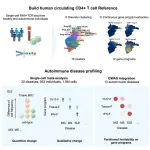(Press-News.org) AI language models are booming. The current frontrunner is ChatGPT, which can do everything from taking a bar exam, to creating an HR policy, to writing a movie script.
But it and other models still can’t reason like a human. In this Q&A, Dr. Vered Shwartz (she/her), assistant professor in the UBC department of computer science, and masters student Mehar Bhatia (she/her) explain why reasoning could be the next step in AI—and why it’s important to train these models using diverse datasets from different cultures.
What is ‘reasoning’ for AI?
Shwartz: Large language models like ChatGPT learn by reading millions of documents, essentially the entire internet, and recognizing patterns to produce information. This means they can only provide information about things that are documented on the internet. Humans, on the other hand, are able to use reasoning. We use logic and common sense to work out meaning beyond what is explicitly said.
Bhatia: We learn reasoning abilities from birth. For instance, we know not to switch on the blender at 2 a.m. because it will wake everyone up. We’re not taught this, but it’s something you understand based on the situation, your environment and your surroundings. In the near future, AI models will handle many of our tasks. We can’t hard code every single common-sense rule into these robots, so we want them to understand the right thing to do in a specific context.
Shwartz: Bolting on common-sense reasoning to current models like ChatGPT would help them provide more accurate answers and so, create more powerful tools for humans to use. Current AI models have displayed some form of common-sense reasoning. For example, if you ask the latest version of ChatGPT about a child’s and an adult’s mud pie, it can correctly differentiate between dessert and a face full of dirt based on context.
Where do AI language models fail?
Shwartz: Common-sense reasoning in AI models is far from perfect. We’ll only get so far by training on massive amounts of data. Humans will still need to intervene and train the models, including by providing the right data.
For instance, we know that English text on the web is largely from North America, so English language models, which are the most commonly used, tend to have a North American bias and are at risk of either not knowing about concepts from other cultures or of perpetuating stereotypes. In a recent paper we found that training a common-sense reasoning model on data from different cultures, including India, Nigeria and South Korea, resulted in more accurate, culturally informed responses.
Bhatia: One example included showing the model an image of a woman in Somalia receiving a henna tattoo and asking why she might want this. When trained with culturally diverse data, the model correctly suggested she was about to get married, whereas previously it had said she wanted to buy henna.
Shwartz: We also found examples of ChatGPT lacking cultural awareness. When given a hypothetical situation where a couple tipped four per cent in a restaurant in Spain, the model suggested they may have been unhappy with the service. This assumes that North American tipping culture applies in Spain when actually, tipping is not common in the country and a four per cent tip likely meant exceptional service.
Why do we need to ensure that AI is more inclusive?
Shwartz: Language models are ubiquitous. If these models assume the set of values and norms associated with western or North American culture, their information for and about people from other cultures might be inaccurate and discriminatory. Another concern is that people from diverse backgrounds using products powered by English models would have to adapt their inputs to North American norms or else they might get suboptimal performance.
Bhatia: We want these tools for everyone out there to use, not just one group of people. Canada is a culturally diverse country and we need to ensure the AI tools that power our lives are not reflecting just one culture and its norms. Our ongoing research aims to foster inclusivity, diversity and cultural sensitivity in the development and deployment of AI technologies.
END
ChatGPT has read almost the whole internet. That hasn't solved its diversity issues
2024-01-11
ELSE PRESS RELEASES FROM THIS DATE:
First direct imaging of small noble gas clusters at room temperature
2024-01-11
For the first time, scientists have succeeded in the stabilisation and direct imaging of small clusters of noble gas atoms at room temperature. This achievement opens up exciting possibilities for fundamental research in condensed matter physics and applications in quantum information technology. The key to this breakthrough, achieved by scientists at the University of Vienna in collaboration with colleagues at the University of Helsinki, was the confinement of noble gas atoms between two layers of graphene. This method overcomes the difficulty that noble gases do not form stable structures under experimental conditions ...
CD4+ T cell patterns linked to autoimmune disorders
2024-01-11
Osaka, Japan – Much like ripples on the water can betray powerful currents below the surface, small changes in our bodies can sometimes be an indicator of a serious condition. Now, researchers from Japan say that cells in the blood may provide telltale signs of important immune dysfunction.
In a study recently published in Cell Genomics, researchers from Osaka University have revealed that subtle changes in specific immune cell populations may signal the presence of an autoimmune disease.
In autoimmune conditions, which affect up to 5% of the population, the body’s immune cells attack the body ...
A tiny tattoo for a tabby
2024-01-11
Tokyo, Japan – If you’ve ever taken a car trip through a rural area, you might already know that livestock, including cows and sheep, can be individually tracked using decidedly old-fashioned methods, such as ear tags or even branding marks. By contrast, many tech-savvy pet owners have opted to have their dog or cat “chipped” by having a radio frequency identification (RFID) permanently implanted under the skin. However, all these identification solutions leave something to be desired, as ear tags can become damaged or lost, while RFID chips require an invasive procedure to insert and specialized equipment to read.
In a study recently published in Scientific ...
JMIR AI has passed the Scientific Quality Review by NLM for PMC
2024-01-11
JMIR Publications is pleased to announce that JMIR AI has passed the Scientific Quality Review by the US National Library of Medicine (NLM) for PubMed Central (PMC). This decision reflects the scientific and editorial quality of the journal. All articles published from 2022 onward will be found on PMC and PubMed after their technical evaluation.
Launched in 2022, JMIR AI is a new journal that focuses on the applications of artificial intelligence in health settings. This includes contemporary developments as well as historical ...
Researchers use spinning metasurfaces to craft compact thermal imaging system
2024-01-11
WASHINGTON — Researchers have developed a new technology that uses meta-optical devices to perform thermal imaging. The approach provides richer information about imaged objects, which could broaden the use of thermal imaging in fields such as autonomous navigation, security, thermography, medical imaging and remote sensing.
“Our method overcomes the challenges of traditional spectral thermal imagers, which are often bulky and delicate due to their reliance on large filter wheels or interferometers,” said research team leader Zubin Jacob from ...
John E. Carlstrom wins 2024 Dannie Heineman Prize for Astrophysics
2024-01-11
WASHINGTON, Jan. 11, 2024 – The Heineman Foundation, American Institute of Physics, and American Astronomical Society are pleased to announce John E. Carlstrom as the winner of the 2024 Dannie Heineman Prize for Astrophysics.
Carlstrom was selected “for pioneering work on microwave interferometry and his leading role in the development of the South Pole Telescope, leading to the observations of clusters of galaxies through the Sunyaev-Zeldovich effect, B-Mode polarization in the cosmic microwave background and strong evidence for a flat universe, all of which changed the field for generations to come.”
“AIP congratulates ...
Intriguing insights uncovered for two rare heart muscle diseases
2024-01-11
PHILADELPHIA— Advancements in the study of two rare heart conditions—peripartum cardiomyopathy (PPCM), and dilated cardiomyopathy (DCM)—contributed by researchers at the Perelman School of Medicine at the University of Pennsylvania may serve as critical guides in future work toward developing therapies for the conditions. The lab of Zoltan Arany, MD, PhD, the Samuel Bellet Professor of Cardiology and a professor of Cell and Developmental Biology, published their findings this month in the New England Journal of Medicine (NEJM), adding to separate research they recently published in the Journal of Clinical ...
Study finds AI-driven eye exams increase screening rates for youth with diabetes
2024-01-11
FOR IMMEDIATE RELEASE
A Johns Hopkins Children’s Center study of children and youth with diabetes concludes that so-called autonomous artificial intelligence (AI) diabetic eye exams significantly increase completion rates of screenings designed to prevent potentially blinding diabetes eye diseases (DED). During the exam, pictures are taken of the backs of the eyes without the need to dilate them, and AI is used to provide an immediate result.
The study noted that the AI-driven technology used in the exams may close “care gaps” among racial and ethnic minority youth with diabetes, populations with historically higher rates of DED and less access to or adherence ...
U.S. health costs related to chemicals in plastics reached $250 billion in 2018
2024-01-11
WASHINGTON—Endocrine-disrupting chemicals (EDCs) in plastics pose a serious threat to public health and cost the U.S. an estimated $250 billion in increased health care costs in 2018, according to new research published in the Journal of the Endocrine Society.
Plastics contain many hazardous, endocrine-disrupting chemicals that leach and contaminate humans and the environment. These chemicals disturb the body’s hormone systems and can cause cancer, diabetes, reproductive disorders, neurological impairments of developing fetuses and children, and death.
Potential options under discussion as part of a Global ...
Experiments in infant mice suggest new way to prevent spread of flu in people
2024-01-11
Scientists have long known that some viruses and bacteria begin infections by latching first onto sugar molecules on the surfaces of cells lining the sinuses and throat of mammals, including humans. Viral particles, for instance, can attach to these molecules, called sialic acids, or SAs, like keys fitting into locks.
Now, a new study in infant mice shows that keeping virus particles from attaching to SAs limits more than just the entry of influenza A viral infections, but also hinders their exit (shedding) and transmission from mouse to mouse. Such infections are the main cause of the seasonal flu that kills more than 36,000 Americans annually. While vaccines to guard ...




